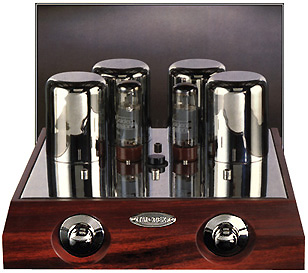Product Review - Micrex L-1 Stereo
Integrated Valve/Solid State Hybrid Amplifier - August, 2000
David Wurtz - Editor, AUSTRALIA
![]()
|
|
Power Output: 75W per channel
minimum. Total Harmonic Distortion: Typically below 0.005% at 1 Watt. Frequency Response: (-3dB Points) 5 Hz to 32 kHz. Hum & Noise: < - 110dB unweighted. Input Sensitivity: 0.05V for full output. Input Impedance: 27 K ohms. Stability: Unconditional. Tube Life: More than 10,000 hours. Power Requirements: 240 Vac 50 Hz 720w maximum or 110 Vac 60 Hz 720w maximum. Weight: 13 Kg (28.4 pounds) Warranty: Two years. Price: $3600AUS (~$2,500 USA) |
Sonique
Audio Pty. Ltd.,
86 Rundle Road, Salisbury South, South Australia 5106;
International Telephone: +61 8 8285 9722; |
Introduction
Presently in Australia and around the world, there is an increasing rediscovery of the use of valves (tubes) in high fidelity amplifiers. There have been a lot of arguments as to the pros and cons of valve technology in hi-fi, but ultimately, how a product sells is almost entirely a reflection on how it sounds.
Sonique Audio, established in 1992 by Steve Lund (Design and Marketing) and Greg Walden (Research & Development), quickly established itself as one of Australia’s leading loudspeaker designers and manufacturers. In 1994 "Micrex" amplifiers (established 1990) approached Sonique for assistance in international marketing, the success of which led to the outright purchase of Micrex by Sonique in 1996.
The Micrex range of amplifiers is visually spectacular. They are available in the "basic" Jarrah foundation with a chrome finish (which looks anything but basic), all the way up to a high gloss Ebony finish with 22ct gold plating. The Micrex amplifiers certainly do look the part, but how do they perform?
The Features
Apart from the striking beauty of the overall package, I was very impressed with its solidity and weight when I removed it from the box. Coming in at just on 13 Kilos, I would not want to leave one of my fingers under it when I put it down! Initial inspection reveals a solidly built timber (Jarrah) base with a meticulously lacquered and finely hand polished finish which is absolutely first class.
Internally, Micrex (Sonique) actually selects, measure, and individually matches all key components, including polypropylene capacitors, metal film resistors, and "In-house" wound inductors. All components are measured to within a tolerance of 1%. Any component measured outside of this tight range is rejected. The signal path through the components is also kept to an absolute minimum, thereby reducing many problems. It also features a 300VA (volt-amp) toroidal mains transformer, high grade audiophile quality internal cabling, and silver soldering throughout.
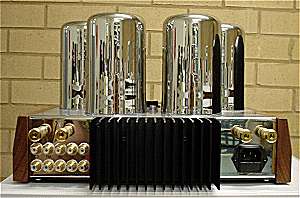 Inspection of the top reveals
four large
chrome domes, two valve sockets, and a black push-button power switch. The
four domes
house two 10,000 �F capacitors for the main power supply and two 4,700 �F (computer grade)
capacitors for the supply to the outputs. All four of these caps have polyester AC
caps
across them to eliminate high frequency oscillations. When the valves are inserted
(the amp came with the valves in their own little boxes), and the amp is turned on, the
four
domes act as reflectors for the valves' heaters, which glow orange in color. This
gives the effect of dozens of small lights reflecting off the amp. The
valves are used in the driver stage, while MOSFETs are used in the output stage.
This is what makes up the "hybrid" design.
Inspection of the top reveals
four large
chrome domes, two valve sockets, and a black push-button power switch. The
four domes
house two 10,000 �F capacitors for the main power supply and two 4,700 �F (computer grade)
capacitors for the supply to the outputs. All four of these caps have polyester AC
caps
across them to eliminate high frequency oscillations. When the valves are inserted
(the amp came with the valves in their own little boxes), and the amp is turned on, the
four
domes act as reflectors for the valves' heaters, which glow orange in color. This
gives the effect of dozens of small lights reflecting off the amp. The
valves are used in the driver stage, while MOSFETs are used in the output stage.
This is what makes up the "hybrid" design.
I found myself turning off all the lights in the room and looking at the lovely little light show put on by the valves on more than one occasion (this is something tube aficionados like to do a lot). On the front of the unit lives the volume control (on the left) and input selector switch (on the right). These large chrome knobs may look a little awkward, but they feel silky smooth to use. I especially liked the feel of the Function Switch.
The rear reveals five pairs of gold plated input RCA jacks (Tape, FM, CD, and Aux IN + Record OUT), two pairs of gold plated speaker output terminals (with "banana plug" support), the AC (grounded) socket, and audio output MOSFET’s heatsink.
This block diagram below shows the signal path.
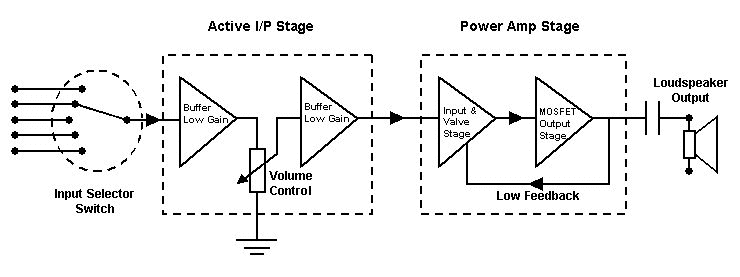
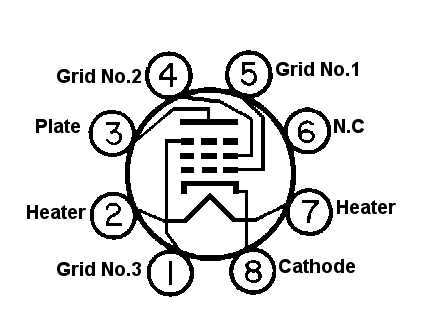 |
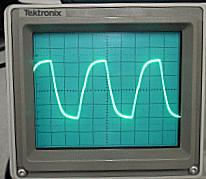 |
The Micrex uses EL-34 valves (see figure on the left for the EL 34's configuration and pin-out) in driver stage, and the speakers are actually powered by high output MOSFET devices. The EL34 or 6CA7 is a power pentode configuration designed especially for high fidelity power amplifiers. It is ideal for the hi-fi purpose as it has extremely low distortion (for a tube) and relatively high "plate dissipation" of 25 Watts.
The waveform shown above, right, is at 10 kHz � 10 Volts, taken with a 1V p-p square-wave input. As you can see, it was not exactly what I put in, but this result is quite typical of Class A valve amplifiers, and is an indicator of the very smooth overall sound.
The Performance
Firstly, let me say that I love doing this job. For me, there are few things more exciting than plugging a new piece of equipment into my reference system and running it through its paces. With that thought in mind, and the anticipation of hearing a new component in my audio setup, I connected it in and powered it up. It is designed with a soft start configuration (about a 3 second pause), and no thumps are heard when it comes on. There is also a slight "tinkle" as the valves warm up.
The first few minutes of listening thoroughly convinced me that I was listening to a very accurate amp. Bass extension was without limit, reproducing wonderfully deep accurate tones. Skunkhour’s album "Feed" has excellent examples of what I think is a very pure bass guitar sound. Bass notes where reproduced so accurately, I momentarily thought I was sitting right next to the bassist’s speaker box. The midrange followed suit with the bass, full of dynamics, with a pleasantly warm reproduction of midrange frequencies. There was no wrestling for position between the low and mid frequencies, even at higher output levels. High frequency reproduction was handled with the same finesse and accuracy as the other frequencies. English band YES’s album "90125", has some fantastic examples of cymbals that sound similar to high frequency explosions. The first thought that came to mind after hearing the way the L1 handled those sounds was that it was like a massive crystal chandelier crashing to the floor. It was nothing short of sensational! As with most hi-fi products, I feel the dynamics of orchestral music to be one of the most defining tests that can be given. The L1 was just as glorious in reproducing the massive soundstage of the finest of Mozart's violin concertos as it was the transients of the mammoth guns in Telarc’s release of Beethoven’s 1812 Overture.
Admittedly, I did drive L1 hard enough that I noticed a bit of distortion in the bass region (mind you the levels I am talking about will cause damage to your ears over extended listening sessions), but realistically, those levels are never likely to be reached by the type of persons who would own an amp of this style and calibre. If you were into driving your loudspeakers to ridiculously high SPL’s, this is not the amp for you. You’d probably be better served buying a power amp that doubles as a MIG welder. Sonique rates the L1 at 75 Watts, which I personally believe is more than enough to handle most situations. On the other hand, because tubes distort generally with second ordered harmonics, even the distorted output of the L1 is easy to listen to.
Finally, I also had the fortune to use the Micrex L1 with one of Sonique's latest release loudspeakers, the 5.5SE. These two products seem to "acoustically mate" (I'm sure Steve Lund would also swear by this). The width of the soundstage increased well beyond my expectations, and an overall increase in depth, definition and stereo imaging was evident. These overall improvements, in comparison to my reference system and the 5.5SEs mated with the L1, were minor, but still excitingly noticeable. It just goes to show that specifically matching components can really pay off.
The overall sound is very smooth, valve-like, but with some of the great sonic features of high quality, transistor style outputs (although, when I say "smooth" I certainly don't mean it lacked any speed or attack). I feel this product to be a near perfect mix of valve and transistor technologies. For $3600AUS, it is mid-priced, but certainly, high-performance.
Conclusion
I was extremely impressed with the overall sound quality of this amp. Not completely valve-ish and not quite transistor-ish, but somewhere pleasantly set in the middle. This is a very classy piece of hardware that possesses both pure sonic excellence and superb aesthetic styling.
- David Wurtz
-
![]()
� Copyright 2000 Secrets of Home Theater & High Fidelity
Return to Table of Contents for this Issue.

